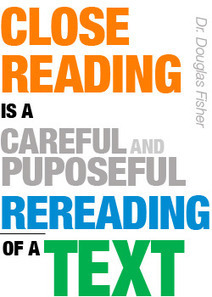What is Close Reading, and how can it help students understand content at deeper levels?
As we embark on our journey into the common core, it is easy to see the merits of greater rigor for students, increased levels of text complexity, and higher expectations for learning. As educators, we embrace these ideas. The evolution of our craft is happening at light speed, and it's good for our students. One can easily understand, however, how teachers might be confused - even intimidated - by the notion that they need to get their students (many of whom are already performing below grade level) to demonstrate their understanding at deeper levels than ever before. Some teachers may be asking, "How do I get a student who has not mastered the art of reading for detail and comprehension to construct a claim about a text and support the assertion with details from the text?" Good question.
One strategy that is a major part of the answer is the concept of close reading. What is close reading? At its core, close reading is a deliberate reading, marking up, and re-reading of a text or excerpt with discussion, debate, and modeling throughout the process. Some important points about close reading to consider:
- Selecting rigorous texts of high complexity for a given group of students is essential to the practice. Ideally, the selection of texts is done as a collaboration among teaching team members. There is a clear rationale for WHY the text is important for the reader.
- Whole texts or chapters are not necessarily the best choice for close readings. Often, an excerpt from a text can be more effective in teaching students to understand essential content at deeper levels. At high levels of implementation, teachers take important excerpts about essential content from multiple sources and design their own short readings, utilizing important text features to help guide students through the text.
- Close reading models active reading strategies that lead to greater levels of comprehension. Over time, close reading helps students internalize these positive reading habits and build the stamina to read longer selections for detail.
- The common core demands that students be able to support their thinking, a practice that should be expected in every classroom at every level. Close reading helps students practice pulling out specific examples from the text to support their answers.
- Reading with a purpose increases students' levels of comprehension. When students are given text-dependent questions prior to reading the selected passage, they read with purpose - like investigators. To maximize learning and allow for stretch, teachers should ask multiple levels of text dependent questions - those that ask for factual recall, those that ask students to infer meaning, those that connect with the author's purpose, and those that speak to the mechanics, usage, and language in the selection. These questions should be purposefully and carefully designed by teams of teachers.
- Marking up the text is an essential part of close reading. As educators, isn't this how we read when we are trying to learn something? We highlight, circle, annotate, etc. Students need practice learning how to do this, and they need to see us model the practice for them - over and over.
- Lively discussion and rigorous debate are important aspects of close reading. Skilled teachers take the time to pause and ask purposeful questions as they guide students through the reading.
See the brief video below from Douglas Fisher to hear a brief explanation of close reading and how it connects to the common core:
Douglas Fisher and Nancy Frey have an excellent resource on Text Complexity and Close Readings that can be found here. The document is a great way to work with teams of teachers in professional learning communities to get started with the practice of close reading.


I read another book this summer about close reading called Notice and Note by Beers and Probst. It helps students find six signposts found in fiction to get them to stop and notice what they are reading. I am going to try the first signpost next week.
ReplyDelete